
| Trumpington Local History Group Trumpington Timeline: 1801 - 1850 |
| Copyright © Trumpington Local History Group, 2016. Updated 11 May 2016. Email: admin@trumpingtonlocalhistorygroup.org |
Edited by Andrew Roberts
Trumpington's history in the first half of the 19th century, including the
enclosure of the village, the development of a network of farms,
population growth and the building of the Cambridge-London railway.
One of a series of pages with Trumpington's timeline.
Trumpington's history in the first half of the 19th century, including the
enclosure of the village, the development of a network of farms,
population growth and the building of the Cambridge-London railway.
One of a series of pages with Trumpington's timeline.
1801
In response to an Act of Parliament, the population of each parish was assessed: Trumpington
was made up of 60 inhabited houses, 0 uninhabited houses, 100 families and 494 people.
Sources of information: Lysons, Daniel and Lysons, Samuel (1808). Magna Britannia.
Cambridgeshire. Republished 1978. Wakefield: EP Publishing. Page 23. The Victoria History
of the Counties of England (1948). The History of the County of Cambridge & the Isle of Ely.
Volume II, page 138. The Victoria History of the Counties of England (1982). A History of
Cambridgeshire and the Isle of Ely, Volume VIII. Armingford and Thriplow Hundreds.
Trumpington, page 249.
In response to an Act of Parliament, the population of each parish was assessed: Trumpington
was made up of 60 inhabited houses, 0 uninhabited houses, 100 families and 494 people.
Sources of information: Lysons, Daniel and Lysons, Samuel (1808). Magna Britannia.
Cambridgeshire. Republished 1978. Wakefield: EP Publishing. Page 23. The Victoria History
of the Counties of England (1948). The History of the County of Cambridge & the Isle of Ely.
Volume II, page 138. The Victoria History of the Counties of England (1982). A History of
Cambridgeshire and the Isle of Ely, Volume VIII. Armingford and Thriplow Hundreds.
Trumpington, page 249.

| Print of the National School, built 1843. From a photograph used by Percy Robinson during lectures in the 1920s-1940s. |
1805-
Lord Byron became a student at Trinity College, Cambridge, and is said to have swam in the
river between Grantchester and Trumpington (the current 'Byron's Pool').
Sources of information: McGann, Jerome (2009). 'Byron, George Gordon Noel, sixth Baron
Byron (1788-1824)', Oxford Dictionary of National Biography.
Lord Byron became a student at Trinity College, Cambridge, and is said to have swam in the
river between Grantchester and Trumpington (the current 'Byron's Pool').
Sources of information: McGann, Jerome (2009). 'Byron, George Gordon Noel, sixth Baron
Byron (1788-1824)', Oxford Dictionary of National Biography.
1801-09
The enclosure of Trumpington was instigated by F.C.J. Pemberton in 1801. He procured an
Inclosure Act with the reluctant agreement of Trinity College (the 'rector') and the Ansteys. The
land was divided after the 1802 harvest and an enclosure map and field map were produced in
1804, but the inclosure award delayed until 1809. The total area was 2312 acres.
Sources of information: Copy of the Enclosure Map, Cambridgeshire Archives, R60/24/2/70(a).
The Victoria History of the Counties of England (1982). A History of Cambridgeshire and the
Isle of Ely, Volume VIII. Armingford and Thriplow Hundreds. Trumpington, page 260.
Local History Group web page: The Agricultural Revolution and Enclosure of Trumpington
The enclosure of Trumpington was instigated by F.C.J. Pemberton in 1801. He procured an
Inclosure Act with the reluctant agreement of Trinity College (the 'rector') and the Ansteys. The
land was divided after the 1802 harvest and an enclosure map and field map were produced in
1804, but the inclosure award delayed until 1809. The total area was 2312 acres.
Sources of information: Copy of the Enclosure Map, Cambridgeshire Archives, R60/24/2/70(a).
The Victoria History of the Counties of England (1982). A History of Cambridgeshire and the
Isle of Ely, Volume VIII. Armingford and Thriplow Hundreds. Trumpington, page 260.
Local History Group web page: The Agricultural Revolution and Enclosure of Trumpington

| The enclosure map of Trumpington: A Map of the Parish of Trumpington in the County of Cambridge, 1804. Reproduced by permission of Cambridgeshire Archives, R60/24/2/70(a). |
1821
Richard Grey Baker publishes a county map of Cambridgeshire which shows
Trumpington.
Sources of information: The Victoria History of the Counties of England
(1982). A History of Cambridgeshire and the Isle of Ely, Volume VIII.
Armingford and Thriplow Hundreds. Page 161.
Richard Grey Baker publishes a county map of Cambridgeshire which shows
Trumpington.
Sources of information: The Victoria History of the Counties of England
(1982). A History of Cambridgeshire and the Isle of Ely, Volume VIII.
Armingford and Thriplow Hundreds. Page 161.
1812
Construction of a windmill to the east of Trumpington Road (on the north side of Long Road
near the Long Road/Trumpington Road junction). The windmill is shown on Baker's 1830 map,
but the Victoria County History gives a date of 1831 for its construction. The mill belonged to
the Moores from 1841 to c. 1900.
Sources of information: Baker, Richard Grey (1830). Baker's Map of the University and Town
of Cambridge, 1830: with an introduction. The Victoria History of the Counties of England
(1982). A History of Cambridgeshire and the Isle of Ely, Volume VIII. Armingford and
Thriplow Hundreds. Trumpington, page 261.
Construction of a windmill to the east of Trumpington Road (on the north side of Long Road
near the Long Road/Trumpington Road junction). The windmill is shown on Baker's 1830 map,
but the Victoria County History gives a date of 1831 for its construction. The mill belonged to
the Moores from 1841 to c. 1900.
Sources of information: Baker, Richard Grey (1830). Baker's Map of the University and Town
of Cambridge, 1830: with an introduction. The Victoria History of the Counties of England
(1982). A History of Cambridgeshire and the Isle of Ely, Volume VIII. Armingford and
Thriplow Hundreds. Trumpington, page 261.
1821
Population of Trumpington 540 people.
Sources of information: The Victoria History of the Counties of England (1948). The History of
the County of Cambridge & the Isle of Ely. Volume II, page 138. The Victoria History of the
Counties of England (1982). A History of Cambridgeshire and the Isle of Ely, Volume VIII.
Armingford and Thriplow Hundreds. Trumpington, page 249.
Population of Trumpington 540 people.
Sources of information: The Victoria History of the Counties of England (1948). The History of
the County of Cambridge & the Isle of Ely. Volume II, page 138. The Victoria History of the
Counties of England (1982). A History of Cambridgeshire and the Isle of Ely, Volume VIII.
Armingford and Thriplow Hundreds. Trumpington, page 249.
1810s-1820s
Remodelling of Trumpington Hall, including
the addition of a third story under a
low-pitched slated roof.
Sources of information: The Victoria History
of the Counties of England (1982). A History
of Cambridgeshire and the Isle of Ely,
Volume VIII. Armingford and Thriplow
Hundreds. Trumpington, page 254. Pevsner,
Nicholas (1970). Cambridgeshire. The
Buildings of England.
Local History Group web page: Trumpington
Hall and the Pemberton Family.
Remodelling of Trumpington Hall, including
the addition of a third story under a
low-pitched slated roof.
Sources of information: The Victoria History
of the Counties of England (1982). A History
of Cambridgeshire and the Isle of Ely,
Volume VIII. Armingford and Thriplow
Hundreds. Trumpington, page 254. Pevsner,
Nicholas (1970). Cambridgeshire. The
Buildings of England.
Local History Group web page: Trumpington
Hall and the Pemberton Family.
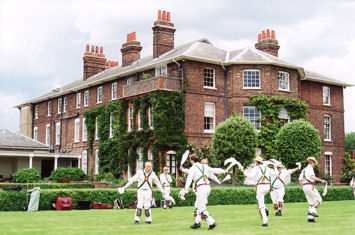
| The Cambridge Morris Men at the Summer Prom in celebration of the 100th anniversary of the opening of the Village Hall, with Trumpington Hall in the background. Photo: Andrew Roberts, June 2008. |
1827-31
Charles Darwin becomes a student at Christ's College, Cambridge, graduating in 1831. Although
Darwin travelled around the Cambridge area, Jon van Wyhe quotes only one reference to
Trumpington: "Professor Sedgwick happened one day to mention a spring issuing from one of
the chalk hills at Trumpington or Coton which deposited carb. of lime very prettily upon twigs
&c. Darwin said to me 'I shall go and test that water myself', which he did and found the fact to
be as Sedgwick had stated it."
Sources of information: Desmond, Adrian, Moore, James and Browne, Janet (2009). 'Darwin,
Charles Robert (1809-1882)', Oxford Dictionary of National Biography. Jon van Wyhe
(2009), Darwin in Cambridge. Christ's College.
Charles Darwin becomes a student at Christ's College, Cambridge, graduating in 1831. Although
Darwin travelled around the Cambridge area, Jon van Wyhe quotes only one reference to
Trumpington: "Professor Sedgwick happened one day to mention a spring issuing from one of
the chalk hills at Trumpington or Coton which deposited carb. of lime very prettily upon twigs
&c. Darwin said to me 'I shall go and test that water myself', which he did and found the fact to
be as Sedgwick had stated it."
Sources of information: Desmond, Adrian, Moore, James and Browne, Janet (2009). 'Darwin,
Charles Robert (1809-1882)', Oxford Dictionary of National Biography. Jon van Wyhe
(2009), Darwin in Cambridge. Christ's College.
1830
Richard Grey Baker publishes a map of
Cambridge which shows most of the parish
of Trumpington.
Sources of information: Baker, Richard
Grey (1830). Baker's Map of the University
and Town of Cambridge, 1830: with an
introduction. (Reproduction published by
the Cambridgeshire Records Society in
1998.)
Richard Grey Baker publishes a map of
Cambridge which shows most of the parish
of Trumpington.
Sources of information: Baker, Richard
Grey (1830). Baker's Map of the University
and Town of Cambridge, 1830: with an
introduction. (Reproduction published by
the Cambridgeshire Records Society in
1998.)
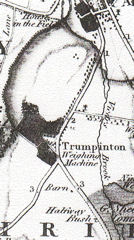
| Detail from Baker's Map of the County of Cambridge, 1821. |
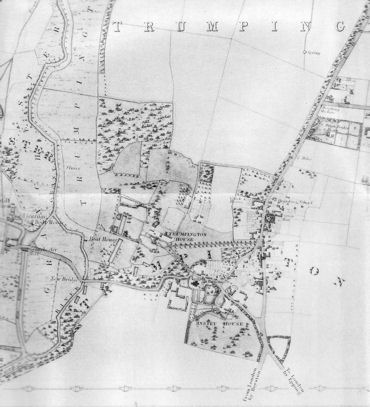
| Detail from Baker's Map of the University and Town of Cambridge, 1830. Reproduced by permission of Cambridgeshire Records Society. |
1838
Anstey Hall was purchased from the Anstey family by Cambridge banker Ebenezer Foster and
remained in the Foster family from 1838-1941.
Sources of information: The Victoria History of the Counties of England (1982). A History of
Cambridgeshire and the Isle of Ely, Volume VIII. Armingford and Thriplow Hundreds.
Trumpington, page 254.
Anstey Hall was purchased from the Anstey family by Cambridge banker Ebenezer Foster and
remained in the Foster family from 1838-1941.
Sources of information: The Victoria History of the Counties of England (1982). A History of
Cambridgeshire and the Isle of Ely, Volume VIII. Armingford and Thriplow Hundreds.
Trumpington, page 254.
1831
Population of Trumpington 150 households, 722 people.
Sources of information: The Victoria History of the Counties of England (1948). The History of
the County of Cambridge & the Isle of Ely. Volume II, page 138. The Victoria History of the
Counties of England (1982). A History of Cambridgeshire and the Isle of Ely, Volume VIII.
Armingford and Thriplow Hundreds. Trumpington, page 254.
Population of Trumpington 150 households, 722 people.
Sources of information: The Victoria History of the Counties of England (1948). The History of
the County of Cambridge & the Isle of Ely. Volume II, page 138. The Victoria History of the
Counties of England (1982). A History of Cambridgeshire and the Isle of Ely, Volume VIII.
Armingford and Thriplow Hundreds. Trumpington, page 254.
1830s
Cuming's School operating in a building to the east of the High Street near the Coach & Horses
public house (a site at the corner High Street and Alpha Terrace, now occupied by St Mary's
House).
Sources of information: Widnall, S.P. [Samuel Page] (1889). Reminiscences of Trumpington
Fifty Years Ago.
Local History Group web page: Education and schools in Trumpington
Cuming's School operating in a building to the east of the High Street near the Coach & Horses
public house (a site at the corner High Street and Alpha Terrace, now occupied by St Mary's
House).
Sources of information: Widnall, S.P. [Samuel Page] (1889). Reminiscences of Trumpington
Fifty Years Ago.
Local History Group web page: Education and schools in Trumpington
1833
Publication of Lord Tennyson's The Miller's Daughter. Tennyson was a student at Trinity
College from 1827 but left without a degree in 1831. The characters and the scenery in the poem
were imaginary but Tennyson apparently said that if he thought of any mill it was that of
Trumpington.
Sources of information: Ricks, Christopher (2006). 'Tennyson, Alfred, first Baron Tennyson
(1809-1892)', Oxford Dictionary of National Biography.
Publication of Lord Tennyson's The Miller's Daughter. Tennyson was a student at Trinity
College from 1827 but left without a degree in 1831. The characters and the scenery in the poem
were imaginary but Tennyson apparently said that if he thought of any mill it was that of
Trumpington.
Sources of information: Ricks, Christopher (2006). 'Tennyson, Alfred, first Baron Tennyson
(1809-1892)', Oxford Dictionary of National Biography.
1845
Construction of the London-Cambridge-Norwich railway
line, the Great Eastern Railway, running from south to
north through the parish to the east of Hobson's Brook,
from Shelford Station to Cambridge Station. Opened 30
July 1845.
Sources of information: The Victoria History of the
Counties of England (1948). The History of the County of
Cambridge & the Isle of Ely. Volume II, page 132. The
Victoria History of the Counties of England (1982). A
History of Cambridgeshire and the Isle of Ely, Volume
VIII. Armingford and Thriplow Hundreds. Trumpington,
page 250.
Local History Group web page: Introduction to Railways in
Trumpington and The Railways of Trumpington,
1845-2010.
Construction of the London-Cambridge-Norwich railway
line, the Great Eastern Railway, running from south to
north through the parish to the east of Hobson's Brook,
from Shelford Station to Cambridge Station. Opened 30
July 1845.
Sources of information: The Victoria History of the
Counties of England (1948). The History of the County of
Cambridge & the Isle of Ely. Volume II, page 132. The
Victoria History of the Counties of England (1982). A
History of Cambridgeshire and the Isle of Ely, Volume
VIII. Armingford and Thriplow Hundreds. Trumpington,
page 250.
Local History Group web page: Introduction to Railways in
Trumpington and The Railways of Trumpington,
1845-2010.
1840s
The Tally Ho public house was listed as a brew
house when it opened on the east side of the High
Street by the 1840s. It brewed its own beer until the
early 1900s and was run for over 50 years by the
same family, the Marshalls, first by James Marshalls
then his son Thomas and finally James's grandson
Edwin.
The Red Lion public house also opened in the
1840s, also on the High Street, between the Tally
Ho and the Green Man, nearly opposite the
crossroads where the War Memorial was later
erected.
Sources of information: Stephen Harper-Scott
[January 2011]. The Victoria History of the
Counties of England (1982). A History of
Cambridgeshire and the Isle of Ely, Volume VIII.
Armingford and Thriplow Hundreds. Trumpington,
page 250.
Local History Group web page: Trumpington Public
Houses
The Tally Ho public house was listed as a brew
house when it opened on the east side of the High
Street by the 1840s. It brewed its own beer until the
early 1900s and was run for over 50 years by the
same family, the Marshalls, first by James Marshalls
then his son Thomas and finally James's grandson
Edwin.
The Red Lion public house also opened in the
1840s, also on the High Street, between the Tally
Ho and the Green Man, nearly opposite the
crossroads where the War Memorial was later
erected.
Sources of information: Stephen Harper-Scott
[January 2011]. The Victoria History of the
Counties of England (1982). A History of
Cambridgeshire and the Isle of Ely, Volume VIII.
Armingford and Thriplow Hundreds. Trumpington,
page 250.
Local History Group web page: Trumpington Public
Houses
1830s
Samuel Page Widnall writes about this period in his Reminiscences published in 1889. Widnall
(1825-94) was a farmer who lived at the Old Vicarage, Grantchester, from 1850, and wrote and
published books about local history.
Sources of information: Widnall, S.P. [Samuel Page] (1889). Reminiscences of Trumpington
Fifty Years Ago. Jennings, Christine (2003). Widnall. A Capital Contriver. the Story of a
Victorian Household in the Village of Grantchester.
Samuel Page Widnall writes about this period in his Reminiscences published in 1889. Widnall
(1825-94) was a farmer who lived at the Old Vicarage, Grantchester, from 1850, and wrote and
published books about local history.
Sources of information: Widnall, S.P. [Samuel Page] (1889). Reminiscences of Trumpington
Fifty Years Ago. Jennings, Christine (2003). Widnall. A Capital Contriver. the Story of a
Victorian Household in the Village of Grantchester.
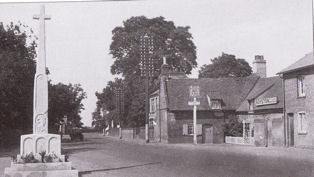
| The Red Lion and the War Memorial. Source: Cambridgeshire Collection, Cambridge Central Library. Reproduced in Trumpington Past & Present, p. 72. |

| The Tally Ho, 1970s. Photo: Peter Dawson. |
1841
Census carried out on 6 June, population of Trumpington 759 people.
Sources of information: The Victoria History of the Counties of England (1948). The History of
the County of Cambridge & the Isle of Ely. Volume II, page 138. The Victoria History of the
Counties of England (1982). A History of Cambridgeshire and the Isle of Ely, Volume VIII.
Armingford and Thriplow Hundreds. Trumpington, page 249.
Local History Group web page: 1841 Census of Trumpington.
Census carried out on 6 June, population of Trumpington 759 people.
Sources of information: The Victoria History of the Counties of England (1948). The History of
the County of Cambridge & the Isle of Ely. Volume II, page 138. The Victoria History of the
Counties of England (1982). A History of Cambridgeshire and the Isle of Ely, Volume VIII.
Armingford and Thriplow Hundreds. Trumpington, page 249.
Local History Group web page: 1841 Census of Trumpington.
1842-43
Purchase of a site and building of the Church
School (National School) on the north side of
Church Street. The school opened in 1843 and
was only replaced by the opening of Fawcett
School in 1950.
Sources of information: The Victoria History of
the Counties of England (1982). A History of
Cambridgeshire and the Isle of Ely, Volume
VIII. Armingford and Thriplow Hundreds.
Trumpington, page 266.
Local History Group web page: Education and
schools in Trumpington
Purchase of a site and building of the Church
School (National School) on the north side of
Church Street. The school opened in 1843 and
was only replaced by the opening of Fawcett
School in 1950.
Sources of information: The Victoria History of
the Counties of England (1982). A History of
Cambridgeshire and the Isle of Ely, Volume
VIII. Armingford and Thriplow Hundreds.
Trumpington, page 266.
Local History Group web page: Education and
schools in Trumpington
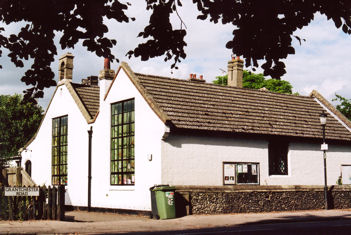
| The former Church School, from Grantchester Road. Photo: Andrew Roberts, August 2008. |
1811
Population of Trumpington 508 people.
Sources of information: The Victoria History of the Counties of England (1948). The History of
the County of Cambridge & the Isle of Ely. Volume II, page 138.
Population of Trumpington 508 people.
Sources of information: The Victoria History of the Counties of England (1948). The History of
the County of Cambridge & the Isle of Ely. Volume II, page 138.
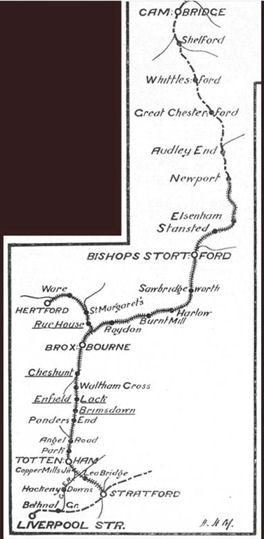
| Map of Northern & Eastern Railway from Stratford (London) to Cambridge, courtesy Railway Magazine. Source: Edmund Brookes. |
1811
A tollgate keeper's house and weighbridge were
constructed on the west side of the Cambridge road near
the junction with the roads to Great Shelford and
Grantchester (now Trumpington High Street). The
building was sold in 1863 and is now a home.
Sources of information: The Victoria History of the
Counties of England (1982). A History of
Cambridgeshire and the Isle of Ely, Volume VIII.
Armingford and Thriplow Hundreds. Trumpington,
page 249. Widnall, S.P. [Samuel Page] (1889).
Reminiscences of Trumpington Fifty Years Ago. Pages
5-6.
Local History Group web page:
A tollgate keeper's house and weighbridge were
constructed on the west side of the Cambridge road near
the junction with the roads to Great Shelford and
Grantchester (now Trumpington High Street). The
building was sold in 1863 and is now a home.
Sources of information: The Victoria History of the
Counties of England (1982). A History of
Cambridgeshire and the Isle of Ely, Volume VIII.
Armingford and Thriplow Hundreds. Trumpington,
page 249. Widnall, S.P. [Samuel Page] (1889).
Reminiscences of Trumpington Fifty Years Ago. Pages
5-6.
Local History Group web page:
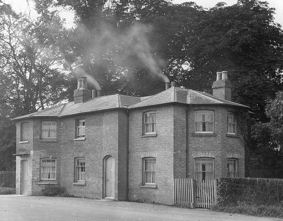
| The Weighbridge House, High Street. From a photograph used by Percy Robinson during lectures in the 1920s-1940s. |
1834-38
The 'new' Poor Law Amendment Act was passed in 1834. This took responsibility for the
administration of poor relief from the parishes and placed it with a network of Unions.
Trumpington was one of 38 parishes in the Chesterton Poor Law Union established on 2 April
1836, which covered a large area around Cambridge.
In 1836-38, the Union built a workhouse in fields in Chesterton, in what became known as
Union Lane. The workhouse had accommodation for 300 people and was built on a prison
model, with four arms making a cross, with intervening yards, and the master's accommodation
in the centre. It provided accommodation together with care for chronically sick paupers who
were excluded from admission to hospital. In the 1930s, the workhouse was converted into a
hospital named the Poor Law Infirmary. When the National Health Service was formed in
1948, Chesterton Hospital became part of the United Cambridge Hospitals. The buildings were
demolished in 2003.
Most poor relief continued to be allocated to people living in the parishes ('outdoor' relief) rather
than those placed in the workhouse. The Union appointed medical officers and took direct
responsibility for the sick poor in the area. In 1849, it became a subscriber to Addenbrooke's
Hospital.
Sources of information: Cambridge University Hospitals web site [accessed 8 January 2011].
Talk to the Chesterton Local History Group about Chesterton Workhouse by Helen Harwood,
18 January 2011. Kirby, Tony and Oosthuizen, Susan (eds.) (2000). An Atlas of
Cambridgeshire and Huntingdonshire History. Cambridge: Anglia Polytechnic University.
Map 65. Rook, Arthur, Carlton, Margaret and Cannon, W. Graham (1991). The History of
Addenbrooke's Hospital Cambridge. Cambridge: CUP. Pages 129-31. The Victoria History of
the Counties of England (1989). A History of the County of Cambridge and the Isle of Ely:
Volume 9 - Chesterton, Northstowe, and Papworth Hundreds. Chesterton, page 12.
The 'new' Poor Law Amendment Act was passed in 1834. This took responsibility for the
administration of poor relief from the parishes and placed it with a network of Unions.
Trumpington was one of 38 parishes in the Chesterton Poor Law Union established on 2 April
1836, which covered a large area around Cambridge.
In 1836-38, the Union built a workhouse in fields in Chesterton, in what became known as
Union Lane. The workhouse had accommodation for 300 people and was built on a prison
model, with four arms making a cross, with intervening yards, and the master's accommodation
in the centre. It provided accommodation together with care for chronically sick paupers who
were excluded from admission to hospital. In the 1930s, the workhouse was converted into a
hospital named the Poor Law Infirmary. When the National Health Service was formed in
1948, Chesterton Hospital became part of the United Cambridge Hospitals. The buildings were
demolished in 2003.
Most poor relief continued to be allocated to people living in the parishes ('outdoor' relief) rather
than those placed in the workhouse. The Union appointed medical officers and took direct
responsibility for the sick poor in the area. In 1849, it became a subscriber to Addenbrooke's
Hospital.
Sources of information: Cambridge University Hospitals web site [accessed 8 January 2011].
Talk to the Chesterton Local History Group about Chesterton Workhouse by Helen Harwood,
18 January 2011. Kirby, Tony and Oosthuizen, Susan (eds.) (2000). An Atlas of
Cambridgeshire and Huntingdonshire History. Cambridge: Anglia Polytechnic University.
Map 65. Rook, Arthur, Carlton, Margaret and Cannon, W. Graham (1991). The History of
Addenbrooke's Hospital Cambridge. Cambridge: CUP. Pages 129-31. The Victoria History of
the Counties of England (1989). A History of the County of Cambridge and the Isle of Ely:
Volume 9 - Chesterton, Northstowe, and Papworth Hundreds. Chesterton, page 12.
1837
There were 10 coaches every weekday from Cambridge to London.
Sources of information: The Victoria History of the Counties of England (1959). The History of
the County of Cambridge & the Isle of Ely. Volume III. The City and University of
Cambridge. City of Cambridge, page 1.
There were 10 coaches every weekday from Cambridge to London.
Sources of information: The Victoria History of the Counties of England (1959). The History of
the County of Cambridge & the Isle of Ely. Volume III. The City and University of
Cambridge. City of Cambridge, page 1.
1849
The last stagecoach ran from Cambridge to London.
Sources of information: The Victoria History of the Counties of England (1959). The History of
the County of Cambridge & the Isle of Ely. Volume III. The City and University of
Cambridge. City of Cambridge, page 1.
The last stagecoach ran from Cambridge to London.
Sources of information: The Victoria History of the Counties of England (1959). The History of
the County of Cambridge & the Isle of Ely. Volume III. The City and University of
Cambridge. City of Cambridge, page 1.
1809
R.B. Harraden published a book
Cantabrigia Depicta, with illustrations of
Cambridge including a plate showing the
supposed scene from the bridge and
milestone on the Trumpington parish
boundary towards King's College, with Coe
Fen on the left and Hobson's Conduit on
the right of the road (page 192). He
describes the context: "There are but few
features to be seen in the different
approaches to this town: the one from the
London road is somewhat striking; the
most conspicuous objects are King's
College chapel, the tower of Great St
Mary's Church, the spire of Trinity church
and part of Downing college. See the view
taken from the one-mile-stone on the
London road." (page 193).
Sources of information: Mike Petty,
Cambridgeshire Engravers.
R.B. Harraden published a book
Cantabrigia Depicta, with illustrations of
Cambridge including a plate showing the
supposed scene from the bridge and
milestone on the Trumpington parish
boundary towards King's College, with Coe
Fen on the left and Hobson's Conduit on
the right of the road (page 192). He
describes the context: "There are but few
features to be seen in the different
approaches to this town: the one from the
London road is somewhat striking; the
most conspicuous objects are King's
College chapel, the tower of Great St
Mary's Church, the spire of Trinity church
and part of Downing college. See the view
taken from the one-mile-stone on the
London road." (page 193).
Sources of information: Mike Petty,
Cambridgeshire Engravers.
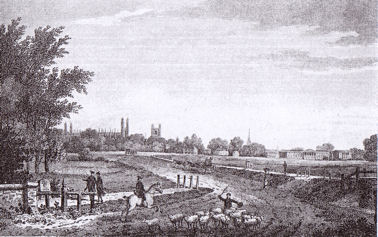
| R.B. Harraden, 1809, 'Cambridge from the London road'. Cantabrigia Depicta, page 192. |
| Timeline pages 1000- 1- 1001- 1501- 1601- 1701- 1801- 1851- 1901- 1951- 2001- 0 BC 1000 AD 1500 1600 1700 1800 1850 1900 1950 2000 present |
1808
Daniel and Samuel Lysons published a 'concise topographic account' of Cambridgeshire, part of
Magna Britannia, a planned series of county volumes. This included information about
Trumpington village, the history of the manors and church and the archaeological background
including prehistoric and Roman roads and finds. In a list of 'gentlemen's seats', it gives two
entries for Trumpington: F.C.J. Pemberton esq and the Reverend Christopher Anstey (in the
occupation of Nathaniel Wedd esq). The Church is described as a "remarkably handsome
uniform building" and there are illustrations of Medieval painted glass and Sir Roger's tomb.
They refer to three turnpike roads from Cambridge to London through Trumpington (the routes
to Chesterford, Fowlmere and Royston).
Sources of information: Lysons, Daniel and Lysons, Samuel (1808). Magna Britannia.
Cambridgeshire. Republished 1978. Wakefield: EP Publishing.
Daniel and Samuel Lysons published a 'concise topographic account' of Cambridgeshire, part of
Magna Britannia, a planned series of county volumes. This included information about
Trumpington village, the history of the manors and church and the archaeological background
including prehistoric and Roman roads and finds. In a list of 'gentlemen's seats', it gives two
entries for Trumpington: F.C.J. Pemberton esq and the Reverend Christopher Anstey (in the
occupation of Nathaniel Wedd esq). The Church is described as a "remarkably handsome
uniform building" and there are illustrations of Medieval painted glass and Sir Roger's tomb.
They refer to three turnpike roads from Cambridge to London through Trumpington (the routes
to Chesterford, Fowlmere and Royston).
Sources of information: Lysons, Daniel and Lysons, Samuel (1808). Magna Britannia.
Cambridgeshire. Republished 1978. Wakefield: EP Publishing.